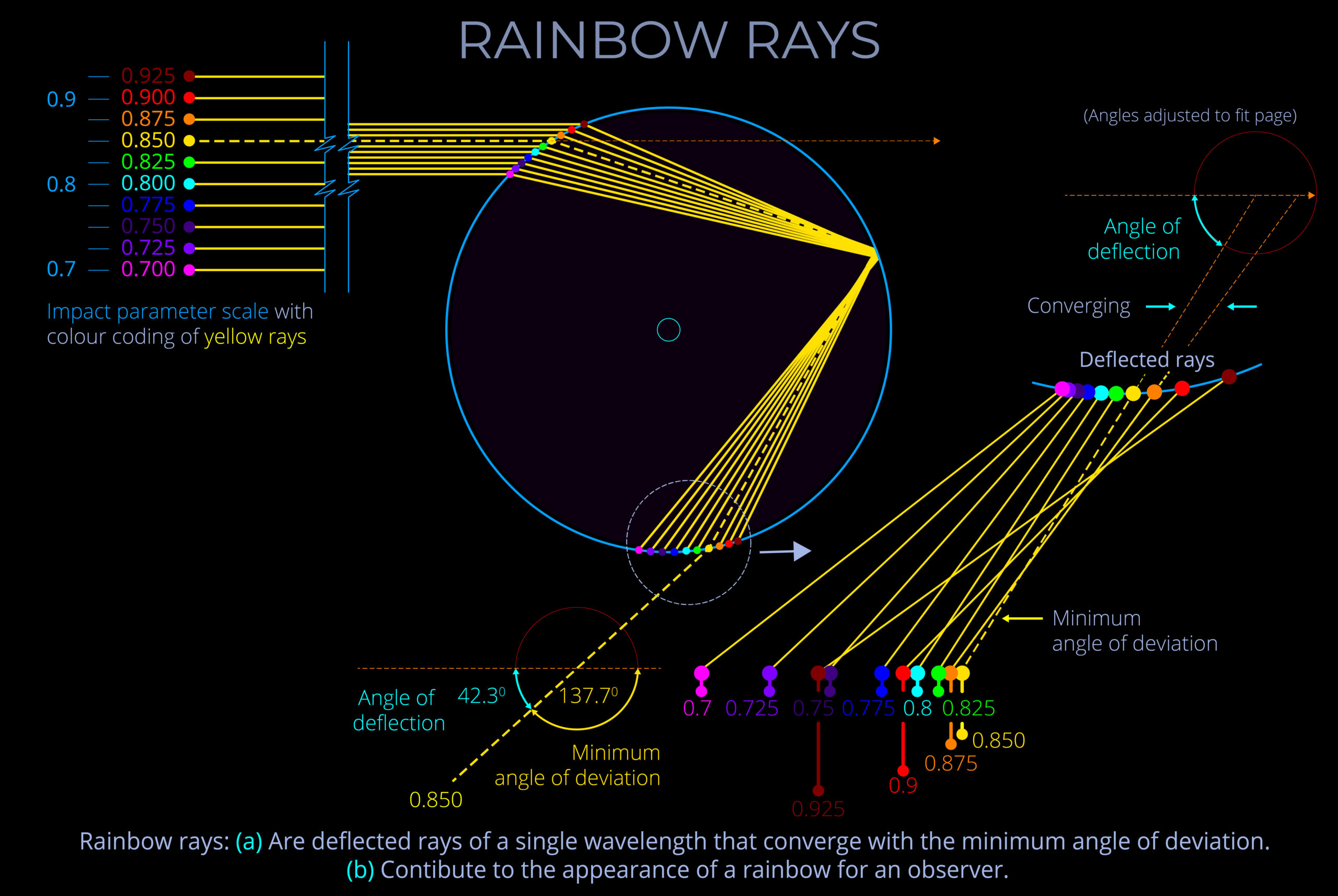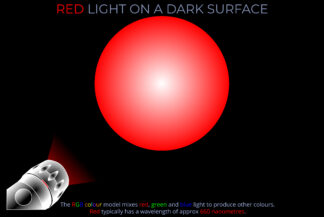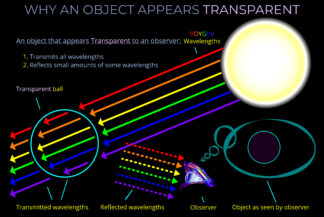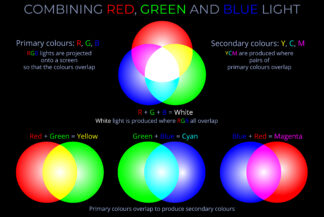Rainbow Rays
£0.00
This is one of a set of almost 40 diagrams exploring Rainbows.
Each diagram appears on a separate page and is supported by a full explanation.
- Follow the links embedded in the text for definitions of all the key terms.
- For quick reference don’t miss the summaries of key terms further down each page.
Description
Rainbow Rays
TRY SOME QUICK QUESTIONS AND ANSWERS TO GET STARTED
The angle of deflection measures the difference between the original path of a ray of incident light before striking a raindrop and the degree to which it must bend to be seen by an observer.
The minimum angle of deviation of a ray of light of any specific wavelength passing through a raindrop is the smallest angle to which it must change course before it becomes visible within the arcs of a rainbow to an observer.
Yes! Every observer has a unique view of the world because: Each one of us sees the world from a different physical location and so has a unique point of view Every one of us has different life experiences including educational, social and cultural factors that affect how we see the world.
Yes! Colour is a visual experience unique to each of us at any given moment because of our different points of view, so we share our experiences of colour using language and by way of examples.
About the diagram
An overview of rainbow rays
- Rainbows are composed of rainbow rays.
- Rainbow rays are responsible for an observer’s perception of a rainbow.
- Rainbow rays are rays of light of a single wavelength that have their origin in individual raindrops. They can be explained in terms of their angular distance from the rainbow axis at the moment they contribute to an observer’s view of a rainbow.
- Rainbow rays are ephemeral. They are not individually observable but more a way of conceptualizing the fact that at a specific moment and in a specific position a raindrop will transmit one spectral colour towards an observer before falling further, perhaps to reappear in a different position and another colour.
- Individual rainbow rays produce the intense appearance of each of the different spectral colours that together constitute the phenomenon of rainbows.
- Rainbows are composed of millions of rainbow rays and each one has its origin within a single raindrop.
- A rainbow ray is a ray of a single wavelength that for a second is responsible for a bright flash of its corresponding colour as a result of being in exactly the right place at the right time.
- Rainbow rays are always located amongst the rays that deviate the least as they pass through a raindrop and bunch together around the minimum angle of deviation.
- The millions of microscopic images of the Sun that produce the impression of a rainbow function in a similar way to the pixels that produce the images we see on digital displays.
- Rainbow rays tend to out-shine all other sources of light in the sky (other than the Sun) and account for the brilliance and imposing appearance of rainbows.
- Because raindrops polarize light at a tangent to the circumference of a rainbow, the path of rainbow rays dissects raindrops exactly in half.
- So:
- Individual rainbow rays account for the appearance of spectral colours of a single wavelength within the arcs of a rainbow.
- Bands of colour within a rainbow are composed of rainbow rays that together transmit narrow spreads of wavelengths towards an observer.
- The overall appearance of a rainbow as a singular phenomenon can be accounted for by optical and geometric rules that determine the passage of light through raindrops and in the process account for rainbow rays.
- Remember: the notion of light rays and rainbow rays are useful when considering the path of light through different media in a simple and easily understandable way. But in the real world, light is not really made up of rays. More accurate descriptions use terms such as photons or electromagnetic waves.
A bit more about rays
Error: View 28a631desj may not exist
About the diagram
- The main drawing on the left shows the paths taken by parallel rays of yellow light (589.29nm) after initially striking the surface of a raindrop at different points.
- The detail on the right shows the path of the deflected rays after they exit the raindrop.
- The incident rays correspond with 0.7 to 0.925 on the impact parameter scale.
- All the rays are of the same wavelength but are coded with coloured buttons so that their paths can be compared.
- The dotted yellow path at 8.50 on the impact parameter scale corresponds with the rainbow ray.
The important thing to notice
- The rainbow ray shown in the diagram is located amongst the rays that deviate the least as they pass through a raindrop and bunch together around the minimum angle of deviation.
- It is difficult to show clearly just how tightly rays bunch together around the minimum angle of deviation.
- It is also difficult to show that at some considerable distance from a raindrop the path of a rainbow ray and a line corresponding with the minimum angle of deviation will always intersect one another.
- This Angles of Deviation Table explains why rays bunch together around the minimum angle of deviation.
Other things to notice
- The paths of the rays follow a predictable pattern because the only variable is their point of impact, as shown on the impact parameter scale.
- The detail on the right shows that after leaving the raindrop that the rays scatter. This scattering is not random but can be shown to follow a predictable pattern determined by their initial angle of refraction
- To understand the geometry that determines their different angles of deflection check out our Angle of Deviation diagram and the carousel of images that appears on that page.
- Don’t forget that the angle of deflection and the minimum angle of deviation always add up to 1800.
Some key terms
Rainbow colours are the colours seen in rainbows and in other situations where visible light separates into its different wavelengths and the spectral colours corresponding with each wavelength become visible to the human eye.
- The rainbow colours (ROYGBV) in order of wavelength are red (longest wavelength), orange, yellow, green, blue and violet (shortest wavelength).
- It is the sensitivity of the human eye to this small part of the electromagnetic spectrum that results in our perception of colour.
- The names of rainbow colours are a matter more closely related to the relationship between perception and language than anything to do with physics or scientific accuracy. While the spectrum of light and the colours we see are both determined by wavelength, it’s our eyes and brains that turn these differences in light into the colours we experience.
- In the past, rainbows were sometimes portrayed as having seven colours: red, orange, yellow, green, blue, indigo and violet.
- Modern portrayals of rainbows reduce the number of colours to six spectral colours, ROYGBV.
- In reality, the colours of a rainbow form a continuous spectrum and there are no clear boundaries between one colour and the next.



